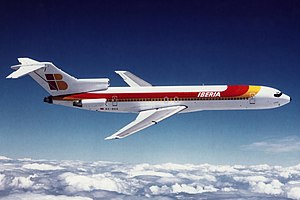Our website is made possible by displaying online advertisements to our visitors.
Please consider supporting us by disabling your ad blocker.
Boeing 727
| Boeing 727 | |
|---|---|
 A stretched 727-200 of Iberia | |
| General information | |
| Type | Narrow-body jet airliner |
| National origin | United States |
| Manufacturer | Boeing Commercial Airplanes |
| Status | In limited cargo and executive service[a] |
| Primary user | Aerosucre |
| Number built | 1,832[2] |
| History | |
| Manufactured | 1962–1984 |
| Introduction date | February 1, 1964, with Eastern Air Lines |
| First flight | February 9, 1963[3] |
The Boeing 727 is an American narrow-body airliner that was developed and produced by Boeing Commercial Airplanes. After the heavier 707 quad-jet was introduced in 1958, Boeing addressed the demand for shorter flight lengths from smaller airports. On December 5, 1960, the 727 was launched with 40 orders each from United Airlines and Eastern Air Lines. The first 727-100 rolled out on November 27, 1962, first flew on February 9, 1963, and entered service with Eastern on February 1, 1964.
The only trijet aircraft to be produced by Boeing, the 727 is powered by three Pratt & Whitney JT8D low-bypass turbofans below a T-tail, one on each side of the rear fuselage and a center one fed through an S-duct below the tail. It shares its six-abreast upper fuselage cross-section and cockpit with the 707 that was also later used on the 737. The 133-foot-long (41 m) 727-100 typically carries 106 passengers in two classes over 2,250 nautical miles [nmi] (4,170 km; 2,590 mi), or 129 in a single class. Launched in 1965, the stretched 727-200 flew in July 1967 and entered service with Northeast Airlines that December. The 20 ft (6.1 m) longer variant typically carries 134 passengers in two classes over 2,550 nmi (4,720 km; 2,930 mi), or 155 in a single class. A freighter and a "Quick Change" convertible version were also offered.
The 727 was used for domestic flights and on international flights within its range. Airport noise regulations have led to hush kit installations. Its last commercial passenger flight was in January 2019. It was succeeded by the 757 and larger variants of the 737. There have been 353 incidents involving the Boeing 727.[4] Production ended in September 1984 with 1,832 having been built. The 727 was an industry workhorse for many years, often fondly referred to as "the DC-3 of the Jet Age."[5]
- ^ Cite error: The named reference
lastcomwas invoked but never defined (see the help page). - ^ "727 Family". Boeing Commercial Airplanes. Archived from the original on May 3, 2012. Retrieved May 14, 2012.
By January 1983, orders reached 1,831. One Boeing-owned test airplane brought the grand total to 1,832.
- ^ "727 Commerciat transport : Historical Snapshot". Boeing.
- ^ "Aviation Safety Network > Boeing 727". aviation-safety.net. Retrieved March 5, 2024.
- ^ "End of an Era: American's Last 727 Flights". aero-news.net. May 1, 2002. Retrieved January 1, 2025.
Cite error: There are <ref group=lower-alpha> tags or {{efn}} templates on this page, but the references will not show without a {{reflist|group=lower-alpha}} template or {{notelist}} template (see the help page).
Previous Page Next Page


